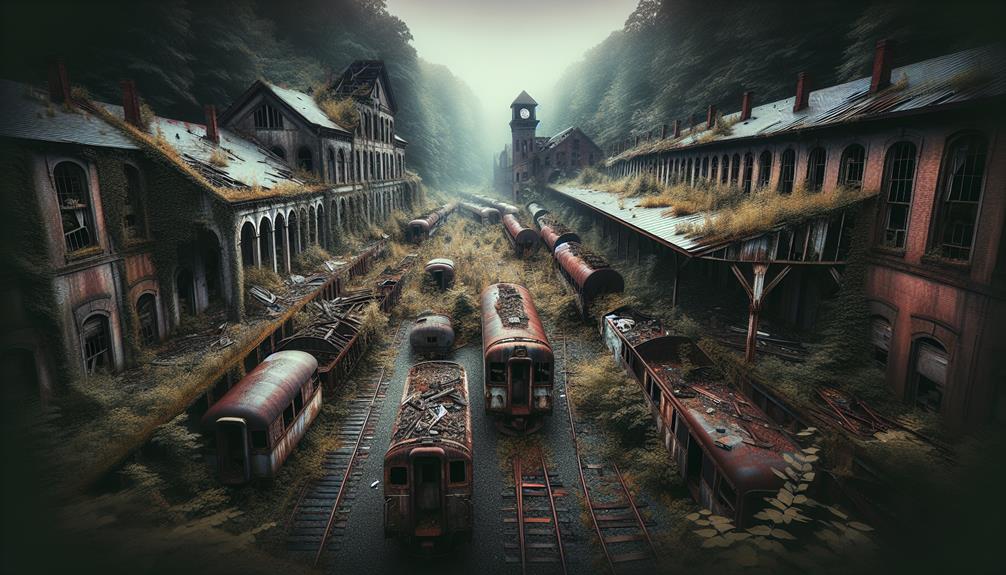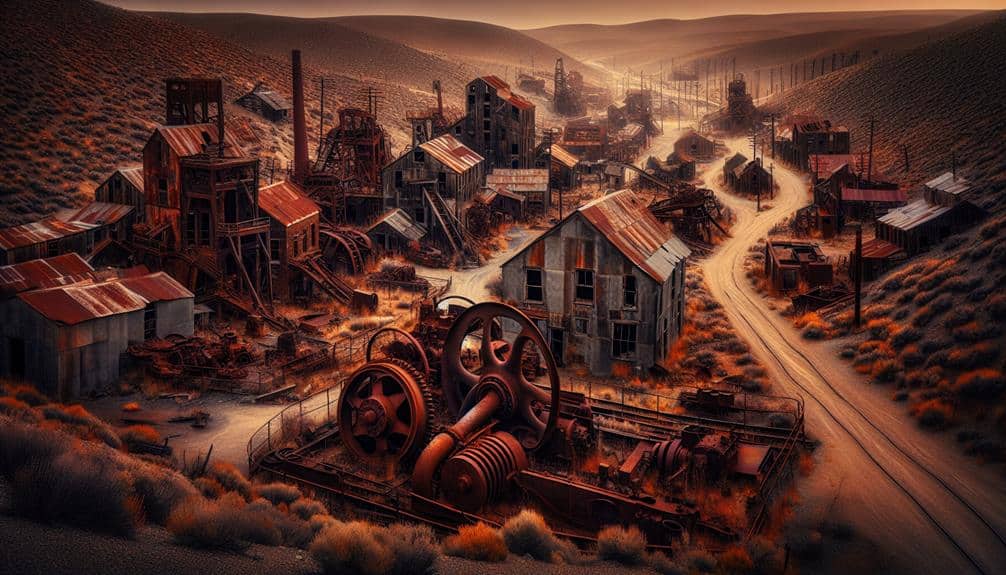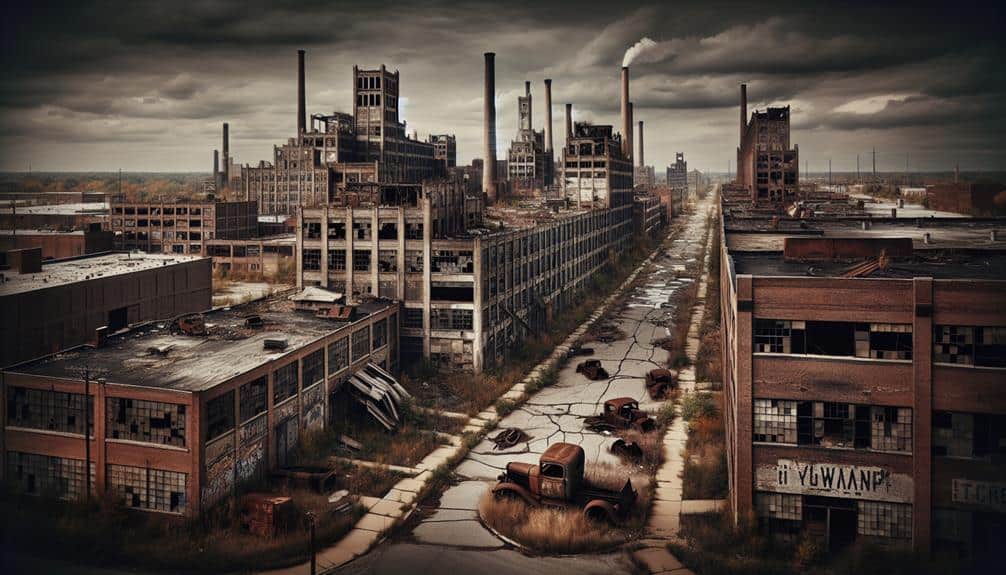Step into the remnants of abandoned railroad towns in the USA. Witness the industrial saga unfold – from bustling hubs to desolate echoes. Railroad expansion birthed these towns, linking raw materials, markets, and people. But as industries shifted, economic winds changed. Workers left, businesses closed, and life ebbed away. These towns stand as ghostly relics of past prosperity, etching the rise and fall of American industry. Explore the untold stories within these forgotten streets, lost in time but holding echoes of an era gone by.
Key Points
- Abandoned railroad towns symbolize economic highs and lows after industrialization.
- Legacy includes the impact of deserted infrastructure on local communities.
- Closure of rail lines resulted in lasting economic consequences for these towns.
- Local businesses suffered due to the decline in railway-related commerce.
- Abandoned rail towns serve as reminders of economic struggles and lost opportunities.
Early Railroad Expansion Impact
The early railroad expansion greatly altered the landscape and vital development of the United States, ushering in a new era of industrial growth and connectivity. The impact of this expansion was profound, transforming the way goods were transported, businesses operated, and communities interacted. As railroads spread across the country, previously isolated areas became linked, creating a web of commerce that spurred economic development and opportunity.
Railroads played an essential role in the development of industries such as steel, coal, and agriculture. They provided a reliable and efficient means of transporting raw materials to factories and finished products to markets. This new mode of transportation not only accelerated the pace of industrialization but also facilitated the growth of urban centers and the expansion of markets.
Furthermore, the railroad expansion led to the creation of new job opportunities, attracting a diverse workforce seeking employment in the burgeoning industries. The increased demand for laborers, engineers, and other skilled workers fueled migration and population growth in areas along the railroad lines. Overall, the early railroad expansion laid the foundation for the economic powerhouse that the United States would become.
Rise of Railroad Industries
With the early railroad expansion revolutionizing industries and fostering economic growth, the rise of railroad industries marked a pivotal turning point in the industrial landscape of the United States. The following points highlight the key aspects of this transformative era:
- Railroad Innovations: The period saw a surge in technological advancements within the railroad sector. Innovations such as the development of locomotives capable of higher speeds and heavier loads revolutionized transportation efficiency, connecting distant regions and enabling the rapid movement of goods and people.
- Economic Impact: The rise of railroad industries had a profound economic impact on the nation. It facilitated the transportation of raw materials to factories and finished products to markets, significantly reducing transportation costs and expanding market reach. The accessibility provided by railroads also spurred the growth of industries, leading to increased production and job opportunities.
- Industrial Revolution Catalyst: The railroad industries acted as a catalyst for the Industrial Revolution in the United States, driving urbanization, stimulating trade, and fostering a new era of industrialization that transformed the country's economic landscape.
Railroad Towns Boom Era
During the Railroad Towns Boom Era, bustling communities emerged along the tracks, reflecting the vibrant pulse of industrial progress in the United States. As the railroads expanded, so did the population of these towns, drawing in people seeking new opportunities and a chance to be part of the economic prosperity sweeping the nation. The growth of these railroad towns wasn't only marked by an increase in residents but also by the development of businesses, schools, and community centers. The influx of workers and settlers fueled a sense of dynamism and ambition, shaping these towns into hubs of innovation and activity.
Economic prosperity thrived in these railroad towns, driven by the constant flow of goods and people along the tracks. Businesses flourished, creating jobs and attracting even more individuals to settle in these vibrant communities. The railroad became the cornerstone of these towns, connecting them to larger cities and markets, facilitating trade, and propelling the economy forward. The Railroad Towns Boom Era was a time of rapid growth and transformation, a reflection of the power of industrialization and the allure of new horizons.
Decline of Railroad Communities
As industrial shifts and economic dynamics evolved, the once thriving railroad communities faced a gradual but inevitable descent into decline.
- Economic Collapse: The decline of industries that once relied heavily on rail transport led to economic collapse in many railroad towns. With the rise of more efficient modes of transportation and changes in consumer preferences, the demand for rail services dwindled, causing businesses to shut down and jobs to disappear.
- Population Migration: The economic downturn forced many residents to seek opportunities elsewhere, leading to a significant population migration away from railroad communities. As jobs became scarce and quality of life diminished, people moved to more prosperous areas in search of better prospects, leaving behind empty houses and deserted streets.
- Abandoned Infrastructure: With the exodus of businesses and residents, infrastructure in these towns began to deteriorate. Rail lines fell into disrepair, buildings crumbled, and once busy streets became eerily quiet, serving as ghostly reminders of a bygone era of prosperity.
Legacy of Abandoned Rail Towns
The legacy of these abandoned rail towns reveals a poignant narrative of industrial rise and fall intertwined with the shifting tides of economic progress and societal change. When examining these once-thriving communities, one can't ignore the lasting impact of their abandoned infrastructure. The skeletal remains of train stations, tracks overtaken by nature, and empty streets speak volumes about a bygone era filled with bustling activity and dreams of prosperity.
The economic repercussions of these abandoned rail towns are still felt today. The closure of rail lines and the subsequent decline of these communities have left behind a stark reminder of the fragility of industrial dependence. Local businesses that once thrived on the bustling railway commerce now stand as empty shells, echoing a time when the trains no longer come. The ripple effect of these closures has reverberated through generations, leaving a legacy of economic hardship and faded opportunities.
As we reflect on the legacy of these abandoned rail towns, we're faced with a sobering reminder of the transient nature of economic landscapes and the enduring impact of industrial decline.
Frequently Asked Questions
How Did the Construction of Railroads Impact Indigenous Communities in the United States?
When railroads were built, they disrupted indigenous communities' way of life. Their impact on these communities was significant, leading to displacement and loss of traditional lands. Cultural preservation efforts are essential to honor and respect their heritage.
What Role Did Immigrant Labor Play in the Development of Railroad Towns?
Immigrant labor was the backbone of railroad town development, shaping communities and fueling growth. Their contributions transformed landscapes, cultures, and economies, highlighting the intricate labor dynamics that propelled industrial expansion in the United States.
Were There Any Notable Instances of Labor Strikes or Worker Unrest in These Railroad Towns?
Labor strikes and worker unrest were common in the railroad towns. Social movements often arose, showcasing community resilience. These events were pivotal in shaping labor rights and challenging the exploitation of workers.
How Did the Decline of the Railroad Industry in the United States Impact the Local Economies of These Abandoned Towns?
When the railroad industry declined in the United States, local economies in these abandoned towns suffered. Businesses were hit hard, leading to community displacement as job opportunities dwindled. The impact was profound and long-lasting.
Are There Any Efforts or Initiatives in Place to Preserve the History and Heritage of These Abandoned Railroad Towns?
Efforts to preserve the history of abandoned railroad towns are vital for heritage preservation and community revitalization. Historical restoration projects can attract tourism, creating economic opportunities and fostering a sense of pride in local heritage.



